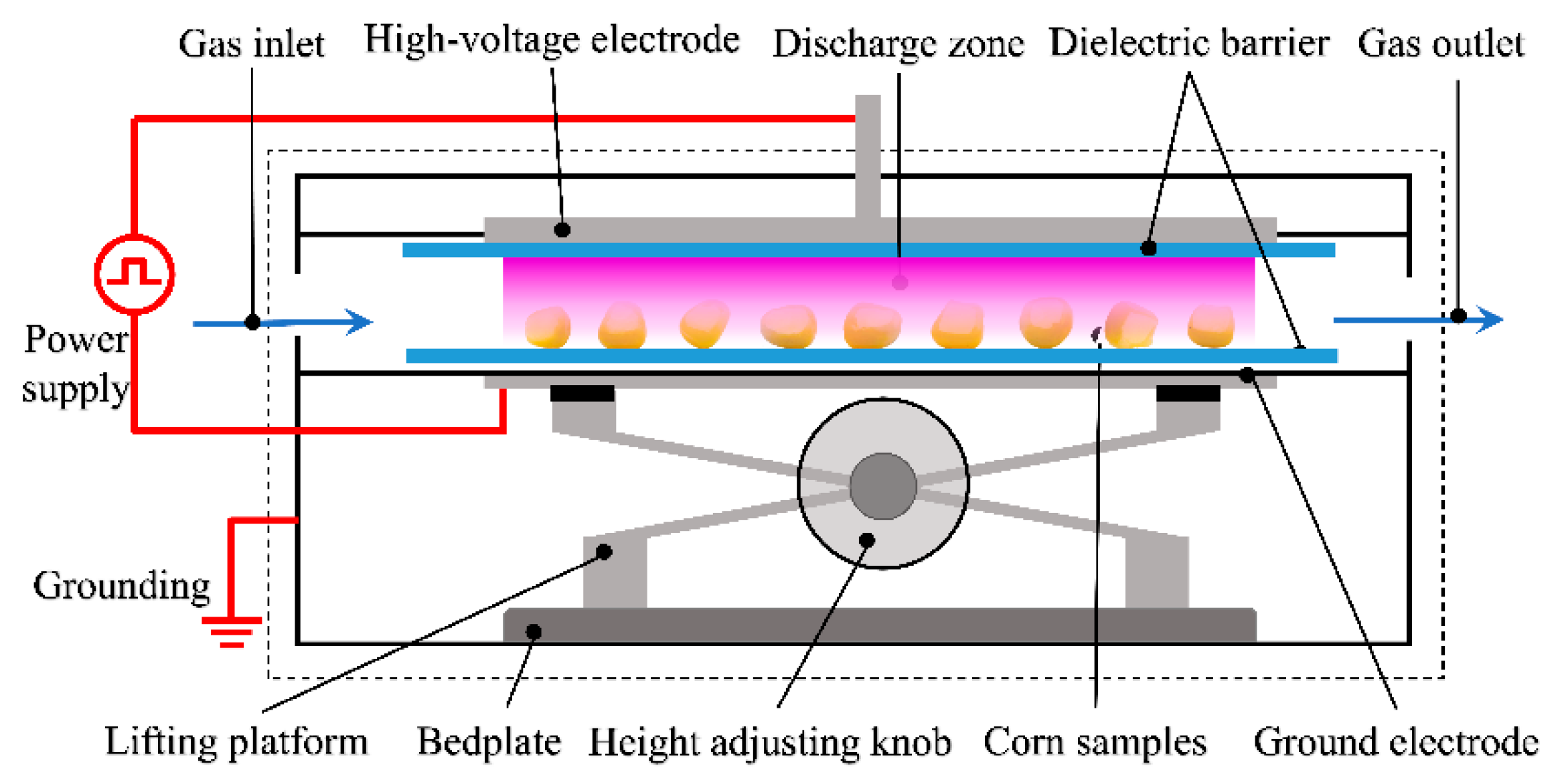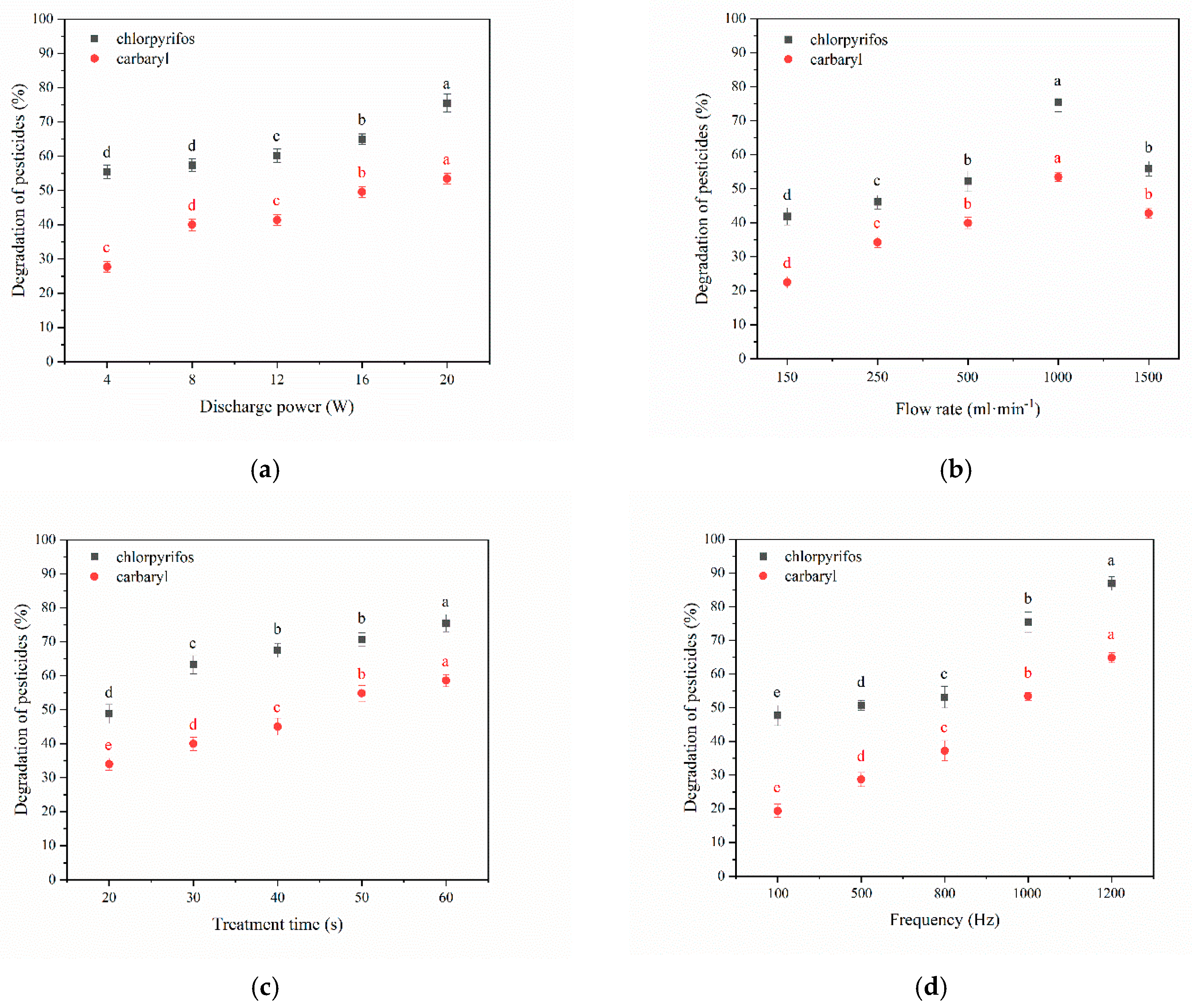Plasma Degradation of Pesticides on the Surface of Corn and Evaluation of Its Quality Changes
Abstract
1. Introduction
2. Materials and Methods
2.1. Reagents and Materials
2.2. Sample Preparation
2.3. Plasma Treatment
2.4. Determination of Pesticide Degradation
2.5. Determination of Physical Changes of Corn Surface
2.6. Determination of Changes in Nutrients Contents of Corn
2.7. Statistical Analysis
3. Results
3.1. Quantification of Pesticides Degradation
3.1.1. Discharge Power
3.1.2. Air Flow Rate
3.1.3. Treatment Time
3.1.4. Frequency
3.2. Evaluation of Physical Changes on the Treated Corn Surface
3.2.1. SEM Micrographs
3.2.2. Contact Angle and Surface Free Energy
3.3. Evaluation of Nutrient Changes in Treated Corn
4. Discussion
5. Conclusions
Author Contributions
Funding
Institutional Review Board Statement
Informed Consent Statement
Data Availability Statement
Acknowledgments
Conflicts of Interest
References
- Kermani, M.; Dowlati, M.; Gholami, M.; Sobhi, H.R.; Azari, A.; Esrafili, A.; Yeganeh, M.; Ghaffari, H.R. A Global Systematic Review, Meta-Analysis and Health Risk Assessment on the Quantity of Malathion, Diazinon and Chlorpyrifos in Vegetables. Chemosphere 2021, 270, 12. [Google Scholar] [CrossRef]
- Malalgoda, M.; Simsek, S. Pesticide Residue in Grain-Based Food: Effects on Health, Grain Quality, and Chemical Properties of Biomacromolecules. Cereal Chem. 2021, 98, 8–16. [Google Scholar] [CrossRef]
- Mahugija, J.A.M.; Kayombo, A.; Peter, R. Pesticide Residues in Raw and Processed Maize Grains and Flour from Selected Areas in Dar Es Salaam and Ruvuma, Tanzania. Chemosphere 2017, 185, 137–144. [Google Scholar] [CrossRef]
- Cullen, P.J.; Lalor, J.; Scally, L.; Boehm, D.; Milosavljevic, V.; Bourke, P.; Keener, K. Translation of Plasma Technology from the Lab to the Food Industry. Plasma Process. Polym. 2018, 15, 1700085. [Google Scholar] [CrossRef]
- Khanh Thi Kim, P.; Huan Tai, P.; Brennan, C.S.; Phimolsiripol, Y. Nonthermal Plasma for Pesticide and Microbial Elimination on Fruits and Vegetables: An Overview. Int. J. Food Sci. Technol. 2017, 52, 2127–2137. [Google Scholar]
- Ikmal Misnal, M.F.; Redzuan, N.; Firdaus Zainal, M.N.; Raja Ibrahim, R.K.; Ahmad, N.; Agun, L. Emerging Cold Plasma Treatment on Rice Grains: A Mini Review. Chemosphere 2021, 274, 129972. [Google Scholar] [CrossRef]
- Gavahian, M.; Sarangapani, C.; Misra, N.N. Cold Plasma for Mitigating Agrochemical and Pesticide Residue in Food and Water: Similarities with Ozone and Ultraviolet Technologies. Food Res. Int. 2021, 141, 110138. [Google Scholar] [CrossRef]
- Dorraki, N.; Mahdavi, V.; Ghomi, H.; Ghasempour, A. Elimination of Diazinon Insecticide from Cucumber Surface by Atmospheric Pressure Air-Dielectric Barrier Discharge Plasma. Biointerphases 2016, 11. [Google Scholar] [CrossRef]
- Sarangapani, C.; O’Toole, G.; Cullen, P.J.; Bourke, P. Atmospheric Cold Plasma Dissipation Efficiency of Agrochemicals on Blueberries. Innov. Food Sci. Emerg. Technol. 2017, 44, 235–241. [Google Scholar] [CrossRef]
- Misra, N.N.; Pankaj, S.K.; Walsh, T.; O’Regan, F.; Bourke, P.; Cullen, P.J. In-Package Nonthermal Plasma Degradation of Pesticides on Fresh Produce. J. Hazard. Mater. 2014, 271, 33–40. [Google Scholar] [CrossRef]
- Liu, T. Analysis of Pesticide Residues in Vegetables and Rice and Dynamics of Chlorpyrifos Digestion in Paddy Fields. Master’s Thesis, Northeast Agricultural University, Harbin, China, 2012. (In Chinese). [Google Scholar]
- Wang, J.D.; You, J.L. Analysis of chlorpyrifos by HPLC. Pesticide 1993, 5, 20–21. (In Chinese) [Google Scholar]
- Yang, Y.; Yang, X. Determination of carbaryl and carbofuran in corn by HPLC. Food Food Ind. 2013, 20, 109–111. (In Chinese) [Google Scholar]
- Fujii, M.; Kato, K.; Imai, M.; Kuwabara, H.; Awano, M.; Hashizaki, K.; Taguchi, H. The Comparison of Surface Free Energy of Human, Yucatan Micropig, and Hairless Mouse Skins and Influence of Surfactant on Surface Free Energy of the Skin. Biol. Pharm. Bull. 2019, 42, 295–298. [Google Scholar] [CrossRef] [PubMed]
- Determination of Water Content in Food; Gb/T 5009.3-2016; Standards Press of China, 2016.
- Determination of Starch Content in Food; Gb/T 5009.9-2016; Standards Press of China, 2016.
- Wang, Z.F. Effects of different storage conditions on fatty acid value of maize. Mod. Food 2020, 18, 16–17. (In Chinese) [Google Scholar]
- Determination of Fat Acidity Value of Grain and Oilseeds; Gb/T 5510-2011; Standards Press of China, 2011.
- Determination of Vitamin B2 Content in Food; Gb/T 5009.85-2016; Standards Press of China, 2016.
- National Food Safety Standard—Maximum Residue Limits of Pesticides in Food; Gb/T 2763-2016; Standards Press of China, 2016.
- Sarangapani, C.; Devi, Y.; Thirundas, R.; Annapure, U.S.; Deshmukh, R.R. Effect of Low-Pressure Plasma on Physico-Chemical Properties of Parboiled Rice. Lwt-Food Sci. Technol. 2015, 63, 452–460. [Google Scholar] [CrossRef]
- Thirumdas, R.; Saragapani, C.; Ajinkya, M.T.; Deshmukh, R.R.; Annapure, U.S. Influence of Low Pressure Cold Plasma on Cooking and Textural Properties of Brown Rice. Innov. Food Sci. Emerg. Technol. 2016, 37, 53–60. [Google Scholar] [CrossRef]
- Bai, Y.; Chen, J.; Yang, Y.; Guo, L.; Zhang, C. Degradation of Organophosphorus Pesticide Induced by Oxygen Plasma: Effects of Operating Parameters and Reaction Mechanisms. Chemosphere 2010, 81, 408–414. [Google Scholar] [CrossRef]
- Gao, L.; Sun, L.; Wan, S.; Yu, Z.; Li, M. Degradation Kinetics and Mechanism of Emerging Contaminants in Water by Dielectric Barrier Discharge Non-Thermal Plasma: The Case of 17β-Estradiol. Chem. Eng. J. 2013, 228, 790–798. [Google Scholar] [CrossRef]
- Yang, Y.T. Study on Decomposition of Carbon Tetrafluoride by Surface Wave Plasma. Master’s Thesis, Dalian Maritime University, Dalian, China, 2020. (In Chinese). [Google Scholar]
- Hatzisymeon, M.; Tataraki, D.; Rassias, G.; Aggelopoulos, C.A. Novel Combination of High Voltage Nanopulses and in-Soil Generated Plasma Micro-Discharges Applied for the Highly Efficient Degradation of Trifluralin. J. Hazard. Mater. 2021, 415, 125646. [Google Scholar] [CrossRef]
- Pankaj, S.K.; Bueno-Ferrer, C.; O’Neill, L.; Tiwari, B.K.; Bourke, P.; Cullen, P.J. Characterization of Dielectric Barrier Discharge Atmospheric Air Plasma Treated Chitosan Films. J. Food Process. Preserv. 2017, 41. [Google Scholar] [CrossRef]
- Gotoh, K.; Yasukawa, A.; Kobayashi, Y. Wettability Characteristics of Poly(Ethylene Terephthalate) Films Treated by Atmospheric Pressure Plasma and Ultraviolet Excimer Light. Polym. J. 2011, 43, 545–551. [Google Scholar] [CrossRef]
- Vesel, A.; Zaplotnik, R.; Primc, G.; Mozetič, M. Evolution of the Surface Wettability of Pet Polymer Upon Treatment with an Atmospheric-Pressure Plasma Jet. Polymers 2020, 12, 87. [Google Scholar] [CrossRef] [PubMed]
- Sujka, M.; Jamroz, J. Characteristics of Pores in Native and Hydrolyzed Starch Granules. Starch-Starke 2010, 62, 229–235. [Google Scholar] [CrossRef]
- Zhang, X.-L.; Zhong, C.-S.; Mujumdar, A.S.; Yang, X.-H.; Deng, L.-Z.; Wang, J.; Xiao, H.-W. Cold Plasma Pretreatment Enhances Drying Kinetics and Quality Attributes of Chili Pepper (Capsicum Annuum L.). J. Food Eng. 2019, 241, 51–57. [Google Scholar] [CrossRef]
- Zou, J.J.; Liu, C.J.; Eliasson, B. Modification of Starch by Glow Discharge Plasma. Carbohydr. Polym. 2004, 55, 23–26. [Google Scholar] [CrossRef]
- Liu, C.C.; Zhang, M.N.; Wu, X.P.; Pei, X.X.; Dang, J.Y.; Zhang, Y.Q.; Xi, Y.J.; Wang, B.S.; Song, X.J.; Li, S.P.; et al. Effects of ret-rogradation of microspraying fertilizer on nitrogen uptake, grain yield and quality of summer maize. Soil Fertil. Sci. China 2019, 6, 108–113. (In Chinese) [Google Scholar]
- Wongsagonsup, R.; Deeyai, P.; Chaiwat, W.; Horrungsiwat, S.; Leejariensuk, K.; Suphantharika, M.; Fuongfuchat, A.; Dangtip, S. Modification of Tapioca Starch by Non-Chemical Route Using Jet Atmospheric Argon Plasma. Carbohydr. Polym. 2014, 102, 790–798. [Google Scholar] [CrossRef]
- Sarangapani, C.; Thirumdas, R.; Devi, Y.; Trimukhe, A.; Deshmukh, R.R.; Annapure, U.S. Effect of Low-Pressure Plasma on Physico-Chemical and Functional Properties of Parboiled Rice Flour. Lwt-Food Sci. Technol. 2016, 69, 482–489. [Google Scholar] [CrossRef]
- Chen, H.H.; Chang, H.C.; Chen, Y.K.; Hung, C.L.; Lin, S.Y.; Chen, Y.S. An Improved Process for High Nutrition of Germinated Brown Rice Production: Low-Pressure Plasma. Food Chem. 2016, 191, 120–127. [Google Scholar] [CrossRef]
- Guidelines for Evaluation of Maize Storage Character; Gb/T 20570-2015; Standardization Administration of the People’s Republic of China: Beijing, China, 2015.



| Treatment Time (s) | Contact Angle (°) | Surface Free Energy and Its Components (mJ·m−2) | |||
|---|---|---|---|---|---|
| H2O | CH2I2 | γs | γsp | γsd | |
| Control | 74.91 ± 2.40 a | 52.16 ± 2.89 a | 36.44 ± 1.44 d | 9.08 ± 1.61 c | 27.35 ± 1.83 a |
| 20 | 63.60 ± 1.54 b | 46.84 ± 2.58 b | 43.51 ± 1.04 c | 15.25 ± 1.06 b | 28.00 ± 0.85 a |
| 30 | 59.22 ± 3.44 bc | 44.80 ± 2.99 b | 46.11 ± 2.11 b | 17.97 ± 2.78 b | 28.24 ± 1.86 a |
| 40 | 57.18 ± 2.55 c | 46.43 ± 2.58 b | 46.89 ± 1.89 ab | 19.98 ± 1.72 ab | 26.91 ± 1.22 a |
| 50 | 55.18 ± 1.42 c | 45.48 ± 1.24 b | 48.28 ± 0.94 a | 21.94 ± 2.45 ab | 26.34 ± 2.20 a |
| 60 | 54.07 ± 2.25 c | 43.24 ± 1.61 c | 50.16 ± 0.72 a | 22.33 ± 1.26 a | 27.83 ± 0.96 a |
| Plasma Treatment | Moisture | Starch | Acid Value | Vitamin B2 |
|---|---|---|---|---|
| (g·100 g−1) | (g·100 g−1) | (g·100 g−1) | (μg·100 g−1) | |
| Control | 13.8 ± 0.15 a | 63.4 ± 0.26 a | 41.2 ± 0.24 c | 49.0 ± 0.15 a |
| 30 s | 13.4 ± 0.10 b | 58.3 ± 0.30 b | 42.9 ± 0.31 b | 51.4 ± 0.25 a |
| 60 s | 12.9 ± 0.15 c | 57.4 ± 0.15 c | 44.8 ± 0.30 a | 49.8 ± 0.89 a |
Publisher’s Note: MDPI stays neutral with regard to jurisdictional claims in published maps and institutional affiliations. |
© 2021 by the authors. Licensee MDPI, Basel, Switzerland. This article is an open access article distributed under the terms and conditions of the Creative Commons Attribution (CC BY) license (https://creativecommons.org/licenses/by/4.0/).
Share and Cite
Liu, H.; Guo, D.; Feng, X. Plasma Degradation of Pesticides on the Surface of Corn and Evaluation of Its Quality Changes. Sustainability 2021, 13, 8830. https://doi.org/10.3390/su13168830
Liu H, Guo D, Feng X. Plasma Degradation of Pesticides on the Surface of Corn and Evaluation of Its Quality Changes. Sustainability. 2021; 13(16):8830. https://doi.org/10.3390/su13168830
Chicago/Turabian StyleLiu, Hongxia, Dingmeng Guo, and Xinxin Feng. 2021. "Plasma Degradation of Pesticides on the Surface of Corn and Evaluation of Its Quality Changes" Sustainability 13, no. 16: 8830. https://doi.org/10.3390/su13168830
APA StyleLiu, H., Guo, D., & Feng, X. (2021). Plasma Degradation of Pesticides on the Surface of Corn and Evaluation of Its Quality Changes. Sustainability, 13(16), 8830. https://doi.org/10.3390/su13168830





